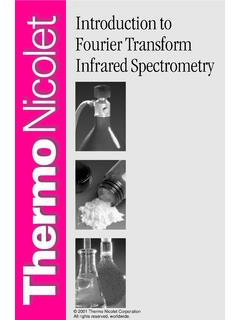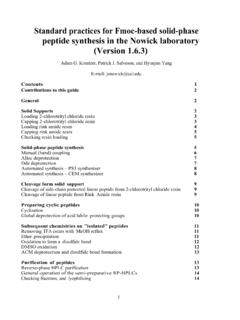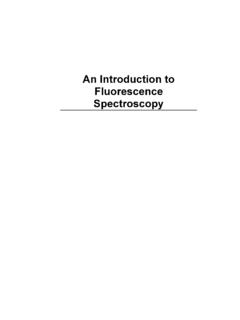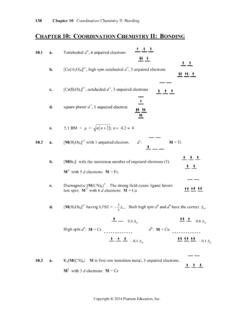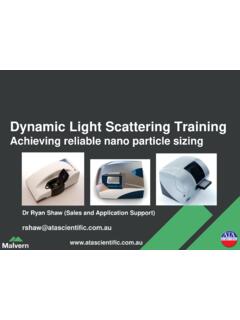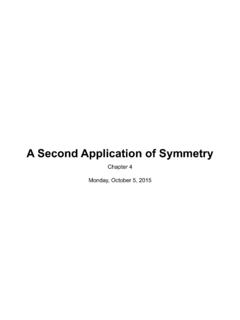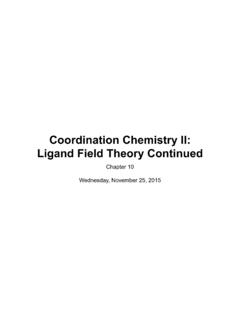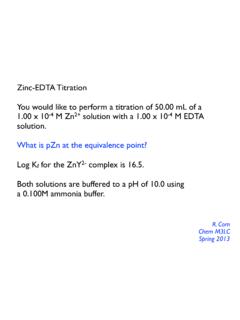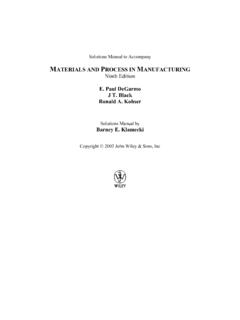Transcription of Raman spectroscopy
1 Raman spectroscopyInformation from Raman SpectroscopycharacteristicRaman frequenciescomposition MoS2,MoO3changes infrequency ofRaman Si 10 cm-1 shift per% strainpolarisation ofRaman peakcrystal symmetry orientation of CVDdiamond grainswidth of Ramanpeakquality amount of plasticdeformationparallelperpendiculari ntensity ofRaman peakamount thickness oftransparent coatingThe coupling of a Raman spectrometer withan optical microscope provides a number ofadvantages:1) Confocal Light collection2) High lateral spatial resolution3) Excellent depth resolution4) Large solid collection angle for theRaman lightCollecting the lightThe basic function of a Raman system Deliver the laser to the sampling point With low power loss through the system Illuminating an area consistent with sampling dimensions Provide a selection/choice of laser wavelengths Collect the Raman scatter High aperture High efficiency optics High level of rejection of the scattered laser light Disperse the scattered light Short wavelength excitation requires high dispersion spectrometers Detect the scattered light Graphically / mathematically present the spectral dataLaser wavelength selection concerns for classical RamanAs the laser
2 Wavelength gets shorter Raman scattering efficiency increases The risk of fluorescence increases (except deep UV) The risk of sample damage / heating increases The cost of the spectrometer increasesRaman light sourceSystem basics: lasers1) UV lasers2) visible lasers3) NIR lasersCommon excitation wavelengths244 nm- biological, catalysts(Resonance Raman )325 nm- wide bandgap semiconductors488 nm & 514 nm- semiconductor, catalysts,biological, polymers, minerals & generalpurpose633 nm- corrosion & general purpose785 nm - polymers, biological & generalpurpose830 nm- biological Illuminate a Sample with an Intense Single Frequency Light Source Measure the relative frequency shift of the inelastically scattered lightGeneric Raman system flow diagramdetectorlasersamplediffractiongra tingRaman microscopy.
3 Dispersive instrument basicsMulti-channelDetectorsampleHNFlase rslitGrating100200300 CountsSystem basics:1) laser2) Rayleigh rejection filter3) grating (resolution)4) CCD detector 18 8 -2 -12 144-6 Dispersion0200 IntensityThe Renishaw Raman spectrometer is an imagingspectrographon-axis stigmatic design with a -70 oC Peltier cooledCCD detector. Advanced inverted mode, deep depletionand UV optimized detectors are available as can easily demonstrate the high quality imaging andsystem performance advantages as seen in the imageof the Si 520 cm-1 Raman band on the CCD of Si 520 cm-1 band pixel numberpixel numberResearch Grade MicroRaman SpectrometerDelivering the light90 and 180 degree scatteringPorto notation90 degree scattering x(z,z)y and180 degree scattering x(z,z)x excitation direction (excitation polarization,scattered polarization) scattering directionThe actual excitation and collection directions are the range of angles0 to mag 2* (deg)
4 X5 29x50 y Delivering the lightDelivering the light (180 degree backscattering)excitationRaman> 90% efficientHolographic notch or edge filter21 Delivering the lightRaman microscope systems typicallyoperate in with the excitation direction andcollected Raman scattering directionseparated 1800. This mode of collectionand excitation is referred to as back-scattering .Typically back-scattered Raman collectionnecessitate special optics that operateboth as a Rayleigh filter and as a lasermirror. Holographic notch filters andspecial dielectric mirrors are often theoptics of choice, since they minimize laserintensity loss and Raman scattering lossesthat would otherwise occur when utilizing apartial laser excitation efficiency andRaman transmission efficiencies can beeasily calculated for most configurationsThe minimum laser focus isdetermined by:1.
5 The focusing optic laser wavefront (distortionor M2)3. How the back aperture ofthe objective is filledLaser focused spot sizeDelivering the lightRaman spectroscopy utilizing a microscopefor laser excitation and Raman lightcollection offers that highest Raman lightcollection properly designed, Ramanmicroscopes allow Raman spectroscopywith very high lateral spatial resolution,minimal depth of field and the highestpossible laser energy density for a givenlaser is important to note that the laserminimum focused spot size is not typicallythe same size as the coupled Ramanscattered spot minimum laser focused spot size isoften compromised by improperly matchingthe laser size to the back aperture of anobjective and by wavefront errors inherentto the laser and introduced by the laserdelivery consideration of the laser mode quality and wavefront, orsource size the minimum laser focused spot for any optic isdescribed by equation 1:Minimum laser focus1) Excitation wavelength: 2) effective numerical aperture.
6 Dl is determined by twice the Rayleigh criteria of the adjacent distancerequired to spatially resolve the presence of an identical size spotsLaser focused spot * =Delivering the laser focused spotsize does not necessarilydefine the lateral spatialresolution of the Ramansystem. The lateralspatial resolution, is oftendiscussed in terms of theRayleigh criteria for thecollected Raman Rayleigh criteriarequires that the distancebetween two pointssources of light of equalintensity be greater thanthe distance from thepeak to the first airy diskminimum. Completediscrimination of twoadjacent materials occursat twice the RayleighcriteriaLaser focused spot sizeDelivering the lightAiry disk pattern Intensityobjective wavelength/ distance umDiffration limited energy densityx50 ( )x20 ( )x5 ( )It s important toremember that theobjective used todeliver the laser lightaffects the laserenergy relative energydensity and peakpower for the X5,X20 and X50objectives areshown relative tothe X50 peak energydensity decreases by~50% for the X20and 87% for the X5objectiveAiry disk calculation for X5, X20 and X50 objective calculated for nm l2* =llDfh The system laser focus depth (hl) is determined by.
7 1) Excitation wavelength: 2) Microscope objective focal length : f3) Effective laser beam diameter at the the objective backaperture: DlLaser focus and depth of fieldDelivering the lightDO NOT CONFUSE LASER FOCUS DEPTH WITH CONFOCAL COLLECTION DEPTH43* =llDf The system laser focus volume ( l) is determined by:1) Excitation wavelength: 2) Microscope objective focal length : f3) Effective laser beam diameter at the the objective backaperture: DlLaser focus and illuminated volumeDelivering the lightDO NOT CONFUSE LASER FOCUS VOLUME WITH CONFOCAL COLLECTION vs. apertureSi Raman intensityOpaque sampleObjective rel 1100X collection angle is proportional to ( )2 not 1/(f/#)^2 Measured vs.
8 Calculated = 4/ *( )2 Collecting the lightOil immersion objectiveincrease is likely due toreduced reflection lossesRelative collection volume0123456400500600700800900 Wavelength (nm)Relative volumeMacro-sampling isimproved with longerwavelength excitationCollecting the light43* =llDf The system laser focus volume ( l)Extended scanning(Renishaw patent EP 0638788)From the Renishaw Raman software the user can select: a fixed grating measurement with a spectrum 'window'of 400 cm-1 to 1000 cm-1 (configuration dependent) a unique 'extended scanning' facility allowing the userto choose any Raman shift range up to about 10000 cm-1(configuration dependent).
9 Essential for extended rangescanning for Raman and photoluminescenceExtended scanning is implemented by moving the grating andthe charge generated on the CCD camera feature is NOT available on any other instrument and isKEY to system performanceCCD BasicsExtended scanning: how it worksExtended scanning vs stitched scanningAdvantages of extended scanninguse a single grating no stitching required and no discontinuities at joinsflexible wavenumber coverage (up to 10000 cm-1 )pixel-to-pixel variation is averaged out - enhancing noise reductionno compromise on resolution across the scanned rangesimple to useAdequate S/NTo acquire useful Raman spectra all you need is.
10 Sufficient spectral and spatial resolution and coverageRepeatabilityThe ability to collect and detect enough photons to distinguish theirelectronic signal above system generated noise before the sample changesor ability to separate spectral peaks narrower than the narrowestanticipated spectral features of your sampleThe ability to collect all of the spectral data required for the analysisThe ability to optically restrict the data collection to an area / volumesmall enough to eliminate acquisition of unwanted spectral data ofnearby substancesThe ability to consistently get the same right or wrong valuesConfocal Raman microscopy without pinhole opticsThe use of a stigmatic spectrograph and stigmatic microscope-spectrometercoupling optics creates two additional conjugate image planes at the slit andCCD eliminating the need for pinhole optics!
